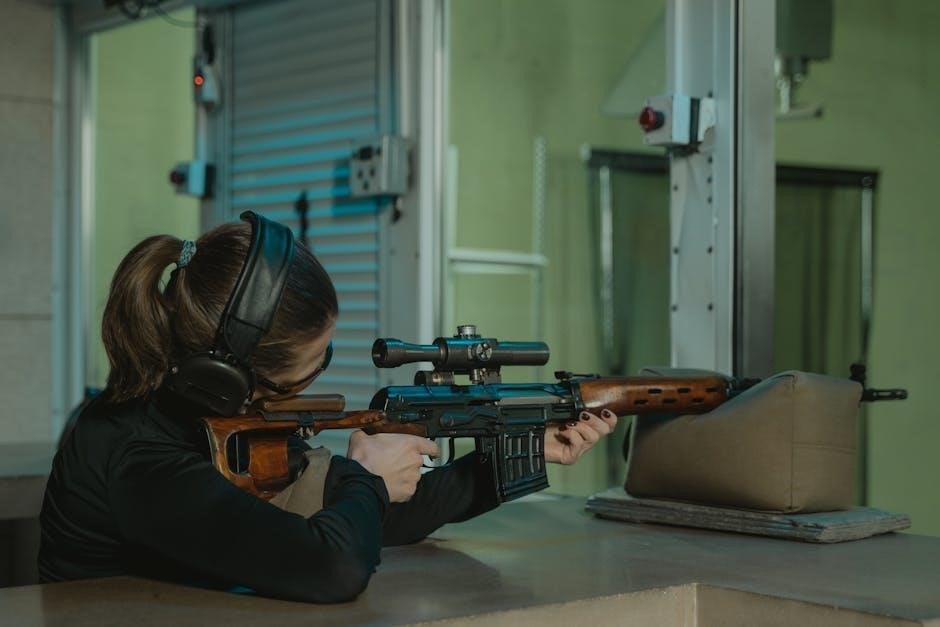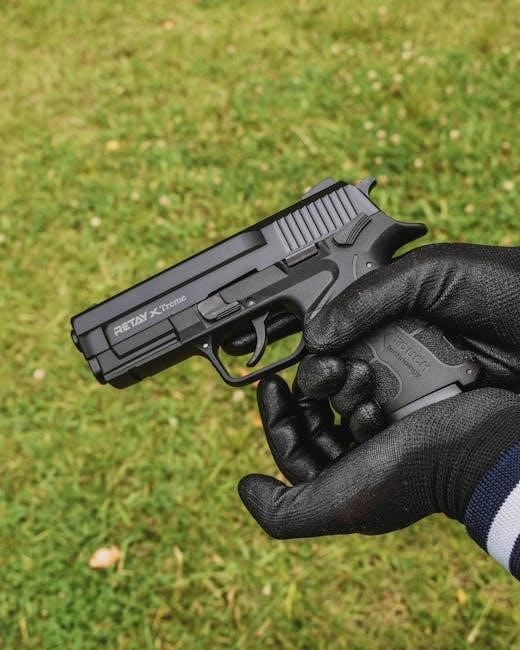Recoil guides are essential components in firearms, designed to manage recoil mechanics. They ensure proper alignment and reduce movement during firing, enhancing accuracy and control. They are critical for maintaining weapon stability and performance, making them a fundamental part of firearm design and functionality.
1.1 Definition and Purpose of Recoil Guides
Recoil guides are mechanical components designed to mitigate recoil forces in firearms, ensuring stability and control during firing. Their primary purpose is to enhance accuracy and reduce muzzle rise, critical for both professional shooters and hobbyists. These guides maintain proper alignment and minimize movement, essential for reliable operation. Typically crafted from durable materials like stainless steel or titanium, they are customizable for various firearms, such as pistols, rifles, and shotguns. Understanding recoil guides is fundamental for optimizing shooting performance and maintaining firearm efficiency, making them indispensable for anyone seeking precision and control in their shooting experience.
1.2 Historical Development of Recoil Guides
The development of recoil guides traces back to early firearms, where managing recoil was crucial for accuracy. Initially, basic mechanisms were used to counter muzzle rise and movement. Over time, advancements in materials and engineering led to more sophisticated designs. In the mid-20th century, stainless steel and titanium became popular, offering durability and reduced weight. Modern recoil guides incorporate precision engineering, with adjustable and universal designs emerging. Historical innovations have laid the foundation for today’s high-performance recoil guides, essential for precision shooting across various firearms.
Types of Recoil Guides
Recoil guides are categorized into fixed, adjustable, and universal types, each designed to accommodate different firearm needs, ensuring optimal performance and customization for various shooting applications and preferences.

2.1 Fixed Recoil Guides
Fixed recoil guides are non-adjustable components designed for specific firearm models, offering a permanent solution for managing recoil. They are pre-sized to fit particular firearms, ensuring minimal movement and consistent performance. These guides are known for their durability and simplicity, requiring no adjustments once installed. They are ideal for shooters who prefer a straightforward, reliable system without the need for customization. Fixed recoil guides are often preferred for their ease of installation and cost-effectiveness, making them a popular choice for both novice and experienced shooters seeking optimal firearm stability and control.
2.2 Adjustable Recoil Guides
Adjustable recoil guides offer customization to suit various shooting styles and firearm types. Unlike fixed guides, these allow users to fine-tune alignment and tension, ensuring optimal performance across different conditions. They are ideal for shooters who need versatility, as they can be tailored to specific needs. Adjustable guides often feature mechanisms for precise calibration, making them suitable for both competitive and tactical use. However, their complexity may require more maintenance and proper installation to function effectively. Despite this, they remain a popular choice for those seeking enhanced control and adaptability in their firearms.
2.3 Universal Recoil Guides
Universal recoil guides are designed to fit a wide range of firearm models, offering versatility for shooters with multiple weapons. Their one-size-fits-all approach makes them a practical choice for general use. Constructed from durable materials, these guides provide consistent performance across various calibers and firearm types. While they may not offer the precise fit of model-specific guides, their adaptability makes them ideal for casual shooters or those experimenting with different firearms. Maintenance is straightforward, ensuring reliability and longevity. Universal recoil guides strike a balance between flexibility and functionality, catering to a broad audience of firearm enthusiasts.

Materials Used in Recoil Guides
Recoil guides are crafted from durable materials like stainless steel, titanium, and ceramic. These materials ensure strength, corrosion resistance, and optimal performance, meeting both functional and regulatory standards.
3.1 Stainless Steel Recoil Guides
Stainless steel recoil guides are highly regarded for their exceptional durability and resistance to corrosion. They are ideal for firearms exposed to harsh environments, as they maintain structural integrity under stress and heavy use. Lightweight and cost-effective, stainless steel guides are a popular choice among manufacturers and shooters. Their smooth surface finish reduces friction, ensuring consistent performance and reliability. With proper maintenance, stainless steel recoil guides can last for years, making them a practical option for both professional and recreational use. Their versatility and strength make them a cornerstone in firearm design.
3.2 Titanium Recoil Guides
Titanium recoil guides are prized for their unique combination of high strength, low weight, and superior corrosion resistance. They are often used in high-performance firearms where minimizing weight without compromising durability is crucial. Titanium’s ability to absorb recoil energy effectively reduces muzzle rise and kickback, enhancing overall shooting comfort. Despite their higher cost, titanium guides are favored for their exceptional performance and longevity. They are ideal for competitive shooters and tactical applications, offering a balance of strength, lightness, and reliability. Titanium recoil guides represent a cutting-edge option for those seeking premium firearm components.
3.3 Ceramic Recoil Guides
Ceramic recoil guides are a modern innovation, offering exceptional hardness and wear resistance. They are designed to withstand extreme conditions, making them ideal for high-impact and high-temperature environments. Ceramic materials reduce friction, ensuring smooth operation and minimizing the risk of mechanical failure. Their lightweight nature also contributes to better weapon balance. While more expensive than metal guides, ceramics provide unparalleled durability and resistance to corrosion. They are a popular choice among enthusiasts seeking low-maintenance, high-performance components. Ceramic recoil guides are a testament to advanced materials science, blending strength, reliability, and tactical practicality.

Installation and Maintenance
Proper installation ensures optimal performance, requiring precise alignment and secure fastening. Regular cleaning prevents debris buildup, while inspections detect wear. Follow manufacturer guidelines for reliability and longevity.
4.1 Choosing the Right Recoil Guide Size
Selecting the correct size for your recoil guide is crucial for optimal performance and firearm stability. Measure the barrel diameter precisely to ensure a snug fit without causing friction. Oversized guides may hinder movement, while undersized ones can compromise control. Refer to the manufacturer’s specifications for compatibility. Proper sizing enhances accuracy and reduces wear. Always test the fit before installation to ensure reliability. Correct sizing ensures smooth operation and maximizes the guide’s effectiveness, making it a critical step in the setup process.
4.2 Step-by-Step Installation Process
Installing recoil guides requires precision to ensure optimal performance. Begin by gathering necessary tools and ensuring the firearm is unloaded. Measure the barrel diameter to confirm guide compatibility. Align the guide with the barrel, ensuring proper positioning. Secure the guide using the manufacturer’s recommended method, such as set screws or adhesive. Tighten evenly to avoid misalignment. Test the firearm to ensure smooth operation and verify guide stability. Follow the manufacturer’s instructions for specific models. Proper installation enhances accuracy and durability, ensuring reliable performance during use. Always double-check alignment and security before firing to guarantee safety and effectiveness.
4.3 Maintenance and Cleaning Tips
Proper maintenance and cleaning of recoil guides are crucial for optimal performance. Use a soft cloth and mild solvent to remove dirt and debris without damaging the material. Avoid harsh chemicals or abrasive tools that could scratch or wear down the guides. Regularly inspect for signs of wear, such as excessive movement or damage, and replace them as needed. Lubricate moving parts to ensure smooth operation and prevent corrosion. Store firearms with recoil guides in a dry, cool environment to maintain longevity. Follow manufacturer guidelines for specific care instructions tailored to your recoil guide material. Consistent upkeep ensures reliability and accuracy.
Recoil Guide Performance Factors
Recoil guide performance is influenced by material quality, design precision, and alignment accuracy. These factors collectively enhance shooting stability, reduce recoil impact, and improve overall firearm efficiency and control.
5.1 Impact on Accuracy and Precision
Recoil guides significantly influence accuracy and precision by stabilizing the firearm during discharge. Their alignment and durability ensure consistent barrel movement, minimizing deviations and enhancing target acquisition. High-quality guides reduce horizontal and vertical shift, allowing shooters to maintain tighter groups. Properly fitted guides prevent misalignment, crucial for precision shooting. Material choice also plays a role, with sturdier options offering better resistance to wear, thereby maintaining consistent performance over time. Effective recoil guides are thus vital for achieving optimal accuracy in both competitive and practical shooting scenarios, making them indispensable for discerning shooters seeking reliable results.
5.2 Reduction of Kickback and Muzzle Rise
Recoil guides play a crucial role in minimizing kickback and muzzle rise, enhancing shooter control. By stabilizing the firearm during discharge, they reduce rearward motion and upward barrel movement. This results in smoother operation, especially during rapid firing. The guides ensure consistent energy absorption, preventing excessive weapon movement. Reduced muzzle rise improves accuracy and allows for quicker target reacquisition. Additionally, controlled kickback decreases shooter fatigue, making extended shooting sessions more manageable. Overall, recoil guides contribute significantly to a firearm’s handling, ensuring a more predictable and controlled shooting experience for users across various applications.
5.3 Durability and Longevity
Durable recoil guides are essential for maintaining firearm performance over time. High-quality materials like stainless steel and titanium ensure resistance to wear and corrosion. Proper installation and maintenance further enhance longevity. Regular cleaning prevents debris buildup, which can degrade guide functionality. Replacing worn guides is crucial to uphold accuracy and control. Investing in durable recoil guides minimizes the need for frequent replacements, ensuring consistent performance. Their longevity directly impacts the reliability of the firearm, making them a critical component for both recreational and professional shooters. A well-maintained recoil guide system ensures optimal firearm operation for years.

Recoil Guides for Specific Firearms
Recoil guides are tailored for pistols, rifles, and shotguns, each requiring specific designs to handle varying weight and recoil dynamics, ensuring optimal performance and shooter comfort.
6.1 Recoil Guides for Pistols
Recoil guides for pistols are designed to manage the upward and rearward movement during firing. They ensure consistent alignment and reduce muzzle rise, improving accuracy and control. Made from durable materials like stainless steel or titanium, these guides are lightweight yet robust. They are often integrated into the pistol’s slide or frame, providing a smooth recoil cycle. Customizable options allow shooters to tailor the guide’s performance to their specific needs, enhancing both competitive and tactical shooting experiences. Proper installation and maintenance are crucial for optimal functionality, ensuring reliable operation under various conditions.
6.2 Recoil Guides for Rifles
Recoil guides for rifles are engineered to manage the rearward motion during firing, enhancing accuracy and control. They are particularly beneficial for high-powered rifles, where recoil can be significant. These guides are typically integrated into the rifle’s stock or receiver, providing a smooth, consistent action. Made from durable materials like stainless steel or titanium, they ensure long-lasting performance. Customizable options allow shooters to tailor the guide’s size and damping levels to suit their specific rifle and shooting style. Proper installation and maintenance are essential for optimal functionality, ensuring reliable operation even under heavy use or harsh environmental conditions.
6.3 Recoil Guides for Shotguns
Recoil guides for shotguns are tailored to mitigate the substantial kickback and muzzle rise inherent in these firearms. Designed for smooth operation, they often feature robust materials like steel or titanium to withstand heavy use. These guides are particularly crucial for competitive shooters and hunters, where consistent aim and reduced fatigue are vital. Adjustable models allow customization to fit various shotgun types and gauges, ensuring optimal performance. Maintenance is straightforward, involving regular cleaning to prevent debris buildup. Proper installation and alignment are essential for maximizing the guide’s effectiveness, ensuring reliable operation and enhanced shooting experience.
Customization and Accessories
Customization and accessories for recoil guides enhance functionality and personalization. Bespoke designs offer tailored fits, while compatible mounts and adapters ensure seamless integration with various firearms, improving both form and function.
7.1 Bespoke Recoil Guide Designs
Bespoke recoil guide designs cater to specific firearm models, ensuring optimal performance. Crafted from high-quality materials like titanium or stainless steel, these custom guides offer tailored fits and enhanced durability. They are engineered to minimize recoil while maintaining precision, making them ideal for competitive shooters and enthusiasts seeking superior control. Custom designs often feature unique finishes and engravings, adding a personal touch. By addressing individual preferences and firearm specifications, bespoke recoil guides provide a seamless integration, elevating both accuracy and aesthetics in shooting experiences.

7.2 Compatible Accessories and Mounts
Compatible accessories and mounts enhance the functionality of recoil guides, ensuring seamless integration with firearms. These include mounts for scopes, flashlights, and other tactical gear, designed to maintain balance and precision. Accessory rails, such as Picatinny or Weaver mounts, allow for easy attachment of additional devices. Customizable plates and adapters further expand compatibility, catering to various firearm models. These accessories improve overall performance by stabilizing the firearm and providing quick detachment options. Integration with smart technology, like recoil-reducing systems, offers advanced control and accuracy. By pairing recoil guides with the right accessories, users can optimize their shooting experience for both recreational and professional use.

Safety Considerations
Proper installation and regular inspection of recoil guides are crucial for safety. Worn guides can cause misalignment and accidents. Always use durable materials and follow manufacturer guidelines.
8.1 Importance of Proper Installation
Proper installation of recoil guides is critical for firearm safety and performance. Misaligned or loosely fitted guides can lead to inaccurate shooting and potential damage. Always follow manufacturer instructions and use precision tools to ensure secure mounting. Regular inspections are essential to identify wear or damage early. Improperly installed guides may cause the firearm to malfunction, posing risks to the shooter and bystanders. Correct installation ensures optimal functionality, enhancing accuracy and reducing kickback. Proper torque specifications must be adhered to, and any deviation can compromise the firearm’s reliability and safety.
8.2 Warning Signs of Worn-Out Recoil Guides
Identifying worn-out recoil guides is crucial for maintaining firearm performance and safety. Look for visible wear, such as excessive scratches or deformation, which can affect alignment. Increased recoil or muzzle rise may indicate worn guides. If the firearm becomes difficult to control or shows inconsistent accuracy, inspect the guides immediately. Unusual noises during firing, like rattling, can signify wear. Regular inspections under bright light will help spot early signs of deterioration. Ignoring these indicators can lead to malfunctions, posing serious safety risks. Always replace worn guides promptly to ensure reliable operation and prevent potential accidents.

Legal and Regulatory Aspects
Recoil guides must comply with local and international firearms regulations. They are subject to certification standards and legal requirements, ensuring safety and adherence to industry norms globally.
9.1 Compliance with Firearms Regulations
Compliance with firearms regulations is crucial for recoil guides. They must meet legal standards set by authorities to ensure safety and functionality. Regional laws may vary, requiring specific materials or designs. Manufacturers must adhere to these regulations to avoid penalties. Proper documentation and certification are essential. Users should verify that their recoil guides comply with local and international firearm laws. Non-compliance can lead to legal consequences. Adhering to these standards ensures reliability and legal use, maintaining public safety and regulatory integrity. Always check regulations before purchasing or installing recoil guides.
9.2 International Standards and Certifications
International standards and certifications ensure recoil guides meet global quality and safety requirements. Organizations like ISO and SAAMI set specific criteria for materials, durability, and performance. Compliance with these standards guarantees reliability and interoperability across different firearm systems. Certifications often involve rigorous testing for stress, corrosion, and precision. Manufacturers must adhere to these guidelines to gain market acceptance. Additionally, some countries impose their own certifications, requiring recoil guides to meet local specifications. These standards ensure consistency and safety, making certified recoil guides more trustworthy for users worldwide. Adhering to international certifications is vital for maintaining product integrity and meeting consumer expectations.

Troubleshooting Common Issues
Troubleshooting recoil guide issues involves diagnosing malfunctions like misalignment or wear. Regular inspection and maintenance are crucial to identify and address problems promptly, ensuring optimal performance and safety.
10.1 Diagnosing Recoil Guide Malfunctions
Diagnosing recoil guide malfunctions requires a systematic approach. Start with a visual inspection for wear or damage, such as scratches or misalignment. Check the guide’s alignment with the firearm’s barrel and action. Test the firearm’s performance during firing; inconsistent accuracy or increased recoil may indicate a malfunction. Use precision tools to measure alignment and ensure proper fitment. Consult the manufacturer’s guidelines for specific diagnostic procedures. Addressing issues early prevents further damage and ensures reliable firearm operation.
10.2 Repair and Replacement Guidelines
When repairing or replacing recoil guides, ensure proper tools and techniques are used to maintain firearm integrity. Inspect the guide for wear or damage; minor scratches may be polished out, while severe damage requires replacement. Use torque specifications provided by the manufacturer to secure new guides. Apply a thin layer of lubricant to moving parts for smooth operation. Test the firearm after installation to ensure proper function and alignment. Always follow safety protocols during repair to avoid accidental discharge or injury. Consult a professional gunsmith if unsure about the process to guarantee reliability and performance.

Future Trends in Recoil Guide Technology
Future trends include advanced materials like carbon fiber and smart technology integration, offering improved durability, reduced weight, and real-time performance monitoring for enhanced firearm efficiency;
11.1 Advancements in Materials Science
Advancements in materials science are revolutionizing recoil guides, with innovations in lightweight yet durable options like carbon fiber and advanced polymers. These materials reduce weight while maintaining strength, improving firearm balance and recoil management. Researchers are also exploring nano-materials for enhanced wear resistance and thermal stability, ensuring longevity under extreme conditions. Additionally, the development of self-lubricating coatings minimizes friction, reducing maintenance needs. Such breakthroughs are setting new standards for recoil guide performance, combining strength, durability, and versatility to meet evolving demands across various firearms applications. These innovations promise to redefine the future of recoil guide technology.
11.2 Integration with Smart Firearms Technology
The integration of recoil guides with smart firearms technology is transforming their functionality. Advanced systems now incorporate sensors and AI to monitor and adapt to recoil patterns in real-time. These smart guides can adjust their stiffness and alignment dynamically, optimizing performance for different loads and firing conditions. Additionally, they can integrate with electronic sighting systems to enhance accuracy and reduce muzzle rise. This fusion of recoil guides with cutting-edge technology creates a more adaptive and responsive firearm, offering shooters greater control and precision. Such innovations are paving the way for a new generation of intelligent, high-performance firearms.
Recoil guides are crucial for firearm performance, ensuring stability and accuracy. Their evolution has enhanced shooting experiences, reducing kickback and improving control, making them indispensable in modern firearms.
12.1 Summary of Key Points
Recoil guides are vital for managing firearm recoil, enhancing stability and accuracy. They cater to pistols, rifles, and shotguns, offering tailored solutions. Materials like stainless steel and titanium ensure durability. Proper installation and maintenance are crucial for optimal performance. Safety considerations, such as adhering to guidelines, prevent malfunctions. Advances in materials and smart technology promise future innovations, further improving effectiveness. Recoil guides are indispensable for modern shooters, ensuring reliable and precise shooting experiences across various firearm types and applications.
12.2 Final Thoughts on the Importance of Recoil Guides
Recoil guides are indispensable for modern shooters, offering unmatched stability, accuracy, and control; Their versatility across pistols, rifles, and shotguns underscores their universal appeal. Durable materials ensure longevity, while customizable designs cater to specific needs. Proper installation and maintenance are critical for safety and performance. As firearm technology evolves, recoil guides remain a cornerstone of reliable shooting systems. Their role in enhancing user experience and precision makes them a vital component for shooters seeking consistency and reliability in every shot.
